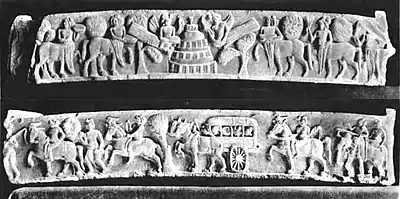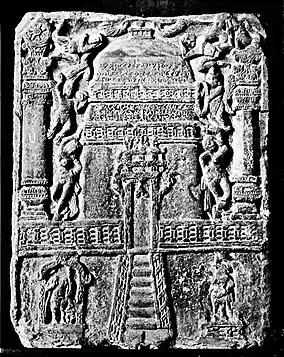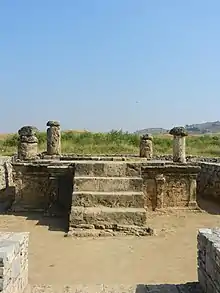Jain stupa
The Jain stupa was a type of stupa erected by the Jains for devotional purposes. A Jain stupa dated to the 1st century BCE-1st century CE was excavated at Mathura in the 19th century, in the Kankali Tila mound.[3]
The inscription reads:
"Adoration to the Arhat Vardhamana. The daughter of the matron (?) courtesan Lonasobhika (Lavanasobhika), the disciple of the ascetics, the junior (?) courtesan Vasu has erected a shrine of the Arhat, a hall of homage (ayagasabha), cistern and a stone slab at the sanctuary of the Nirgrantha Arhats, together with her mother, her daughter, her son and her whole household in honour of the Arhats."[2]

Jain legends state that the earliest Jain stupa was built in the 8th century BCE, before the time of the Jina Parsvanatha.[4]
There is a possibly that the Jains adopted stupa worships from the Buddhists, but that is an unsettled point.[5] However the Jain stupa has a peculiar cylindrical three-tier structure, which is quite reminiscent of the Samavasarana, by which it was apparently ultimately replaced as an object of worship.[6] The name for stupa as used in Jain inscriptions is the standard word "thupe".[6]
Mathura Jain stupas
A Jain stupa dated to the 1st century BCE-1st century CE was excavated at Mathura in the 19th century, in the Kankali Tila mound.[3] Numerous associated religious works of art were also discovered during the excavations.[3] Many of these are votive tablets, called ayagapatas.[7] They are numerous, and some of the earliest ones have been dated to circa 50-20 BCE.[8]
According to Jain legends, five Jain stupas were built in Mathura.[6]
Ayagapatas
The Jain devotional reliefs called Ayagapatas, particularly that dedicated by Vasu, shows a probable design of the Jain stupa.[6] The stupa drum is set on a high platform, and accessed by a flight of stairs and an ornate torana gate, quite similar in style to the toranas of Sanchi.[6] Niches with images can be seen in front of the platform.[6] The drum of the stupa is elongated and cylindrical, and formed of three superposed tiers separated by railings and decorated bands.[6] The stupa starts to round off only above these three tiers.[6] The platform may have been squared, with Persepolitan-type columns in each corner, similar to those seen in the Vasu Ayagapata.[6] On the Vasu ayagapata, one of the Persepolitan pillars is surmounted by a Dharmachakra wheel, and the other pillar was probably surmounted by an animal, as seen in other similar ayagapatas.[6]
The Sivayasa ayagapata shows clearly two triratna symbols on top of the torana, as well as a central flame palmette design.[6]
Jain stupas in narrative reliefs

.jpg.webp)
By 100 BCE, a relief from Mathura is known, the Kankali Tila architrave, representing centaurs worshipping a Jain stupa.[14][15]
Here again the Jain stupa in the middle of the relief is of cylindrical type with a three-tier design, separated by three horizontal railings.[6]
These reliefs are among the first known examples of Jain sculpture.[16] The centaurs appearing in the Mathura reliefs, as in other places such as Bodh Gaya, are generally considered as Western borrowings.[17] Robert Graves (relying on the work of Georges Dumézil,[18] who argued for tracing the centaurs back to the Indian Gandharva), speculated that the centaurs were a dimly remembered, pre-Hellenic fraternal earth cult who had the horse as a totem.[19]
See also
References
- Quintanilla, Sonya Rhie (2000). "Āyāgapaṭas: Characteristics, Symbolism, and Chronology". Artibus Asiae. 60 (1): 79–137 Fig.26. doi:10.2307/3249941. ISSN 0004-3648. JSTOR 3249941.
- "Collections-Virtual Museum of Images and Sounds". vmis.in.
- Smith, Vincent Arthur (1901). The Jain stûpa and other antiquities of Mathurâ. Allahabad: KFrank Luker, Superintendent, Government Press, North-Western Provinces and Oudh.
- "According to one legend, the earliest Jain stupa (a funerary or reliquary mound, usually grandly ornamented and enclosed by a railing with an elaborate gateway) was built before the time of the Jina Parsvanatha in the eighth century B.C." in Arts of Asia. 1994.
- Sethia, Tara (2004). Ahimsā, Anekānta, and Jaininsm. Motilal Banarsidass Publ. p. 200. ISBN 978-81-208-2036-4.
- Shah, Umakant Premanand (1987). Jaina-rūpa-maṇḍana. Abhinav Publications. p. 15–17. ISBN 978-81-7017-208-6.
- The Jain stûpa and other antiquities of Mathurâ by Smith, Vincent Arthur Plate XIV
- Quintanilla, Sonya Rhie (2007). History of Early Stone Sculpture at Mathura: Ca. 150 BCE - 100 CE. BRILL. p. 403, Fig. 146. ISBN 9789004155374.
- "the massive pillars in the Persian Achaemenian style" in Shah, Chimanlal Jaichand (1932). Jainism in north India, 800 B.C.-A.D. 526. Longmans, Green and co.
- "The Ayagapata which had been set up by Simhanddika, anterior to the reign of Kanishka, and which is assignable to a period not later than 1 A.D., is worth notice because of the typical pillars in the Persian-Achaemenian style" in Bulletin of the Baroda Museum and Picture Gallery. Baroda Museum. 1949. p. 18.
- Kumar, Ajit (2014). "Bharhut Sculptures and their untenable Sunga Association". Heritage: Journal of Multidisciplinary Studies in Archaeology. 2: 223‐241.
- Quintanilla, Sonya Rhie (2007). History of Early Stone Sculpture at Mathura: Ca. 150 BCE - 100 CE. BRILL. pp. Fig. 21 and 22. ISBN 9789004155374.
- Bronkhorst, Johannes (2016). How the Brahmins Won: From Alexander to the Guptas. BRILL. p. 466. ISBN 9789004315518.
- Quintanilla, Sonya Rhie (2007). History of Early Stone Sculpture at Mathura: Ca. 150 BCE - 100 CE. BRILL. pp. 36–51. ISBN 9789004155374.
- Kumar, Raj (2003). Essays on Indian Art and Architecture. Discovery Publishing House. pp. 50–51. ISBN 9788171417155.
- Cort, John (2010). Framing the Jina: Narratives of Icons and Idols in Jain History. Oxford University Press. pp. 25–26. ISBN 9780199739578.
- "The hippocamps, the tritons, centaurs and other weird creatures, which certainly were borrowed from Western Art, occur at Gaya and other places, in the sculptures of the early period. Forms more or less similar occur at Mathura and Arnaravati." Banerjee, Gauranga Nath (1920). Hellenism in ancient India. Calcutta. p. 64.
- Dumézil, Le Problème des Centaures (Paris 1929) and Mitra-Varuna: An essay on two Indo-European representations of sovereignty (1948. tr. 1988).
- Graves, The Greek Myths, 1960 § 81.4; § 102 "Centaurs"; § 126.3;.
- Quintanilla, Sonya Rhie (2007). History of Early Stone Sculpture at Mathura: Ca. 150 BCE - 100 CE. BRILL. pp. Fig. 21 and 22. ISBN 9789004155374.





